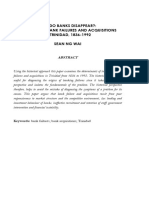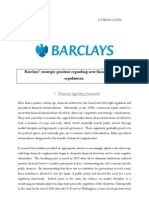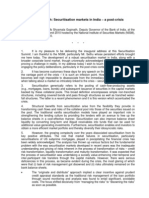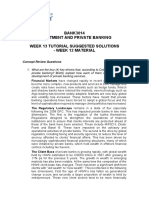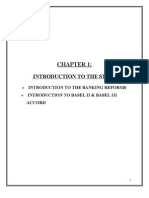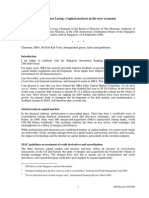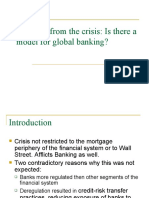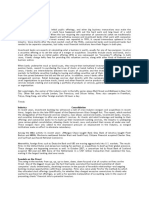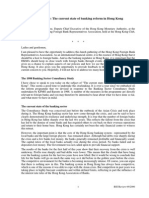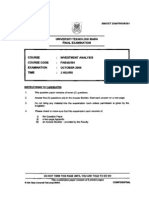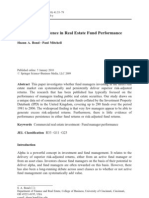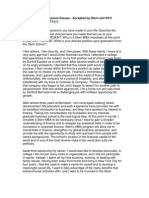Why Do Banks Disappear?: A History of Bank Failures and Acquisitions in Trinidad, 1836-1992
Why Do Banks Disappear?: A History of Bank Failures and Acquisitions in Trinidad, 1836-1992
Uploaded by
Sauvik ChakrabortyCopyright:
Available Formats
Why Do Banks Disappear?: A History of Bank Failures and Acquisitions in Trinidad, 1836-1992
Why Do Banks Disappear?: A History of Bank Failures and Acquisitions in Trinidad, 1836-1992
Uploaded by
Sauvik ChakrabortyOriginal Title
Copyright
Available Formats
Share this document
Did you find this document useful?
Is this content inappropriate?
Copyright:
Available Formats
Why Do Banks Disappear?: A History of Bank Failures and Acquisitions in Trinidad, 1836-1992
Why Do Banks Disappear?: A History of Bank Failures and Acquisitions in Trinidad, 1836-1992
Uploaded by
Sauvik ChakrabortyCopyright:
Available Formats
Why do banks disappear?
: A History of Bank Failures and Acquisitions in Trinidad, 18361992
ABSTRACT
The history of banking in Trinidad offers a rich array of banking failures and acquisitions from which policymakers can draw lessons. Using the historical approach, this paper examines the determinants of individual bank failures and acquisitions in Trinidad during the period 1836 to 1992. The historical approach is useful for diagnosing the origins of banking failures since it takes a long-term perspective. Second, by focussing on particular events, the historical approach isolates the fundamentals of the problem, not to be preoccupied by arguments over the efficiency or desirability of particular policies for specific current problems. The historical perspective therefore, helps to avoid the mistake of diagnosing the symptoms of a problem for its causes. This paper argues that bank failure and acquisitions result from poor responsiveness to market structure and the competitive environment, lax lending and investment behaviour of banks, ineffective recruitment and retention of staff, government intervention and financial instability.
Keywords: Bank failures; Bank Acquisitions; Trinidad
Sean Ng Wai University of the West Indies Department of History
Introduction As the worst economic crisis in decades continues to take its toll, many banks will disappear from the market because of failure or through consolidation with other banks. Bank failure occurs when a bank is unable to meet its obligations to its depositors or other creditors, owing to unwarranted depositor withdrawals during events characterised by contagion or panic, or as a result of fundamental bank insolvency. In an attempt to avert imminent failure, some banks may consolidate their operations with other banks through acquisitions or mergers. An acquisition usually refers to an arms length deal, with the shares of the target firm being acquired in an act of mutual exchange and the owners of the acquired firm accepting cash, securities or some combination of both, in return for their shares. While in a merger one or both of the firms cease to exist, in an acquisition the acquired firm becomes a subsidiary.1 In cases where one company acquires all the assets of another company, the target company becomes merely a shell and will eventually liquidate. Contrastingly, a merger refers to a combination of two or more companies, generally by offering the stockholders of one company securities in the acquiring company in exchange for the surrender of their stock. A merger results in the creation of a new reporting entity formed from the combining businesses. Bank consolidation is not only a mechanism for rationalising the operations of weaker firms, but can also be viewed as part of a normal process of growth. While there is a rich array of literature on the history of bank failure and firm consolidation, many of these surveys focus on the large economies at the centre rather than at the periphery, more specifically with regard to Trinidad. This is partly due to the fact that banks prior to 1970 were merely branches, which took instructions from multinational banks at the centre. As such, the domestic environment in which the branch operated was deemed to be irrelevant in the decision-making process. An examination of the history of banking in Trinidad, however, will show that such a perspective is misleading and inaccurate. In recent times, Augustine Nelson (1995) and Glenn Khan (2001) have researched bank failure and bank consolidation in post-1962 Trinidad and Tobago. There has been some attempt to examine the history of the banking sector in Trinidad and Tobago by Deryck Brown (1989) and in the corporate histories of Republic Bank (1987), Scotiabank (2004) and First Citizens (2007). With the exception of First Citizens corporate history, little attempt has been made by these texts to investigate why banks disappear. The subject of bank failure and consolidation has been the speciality of economists, who use various mathematical models to measure bank performance, asset quality, operating efficiency, managerial competence among other criteria. These models, however, often disregard the heterogeneity of decision rules and the impact of societal changes on firm performance. Moreover, economic models are based on the assumptions 2
of rational expectations and a representative agent. 2 As a consequence, economic models often fall short of capturing and measuring the dynamic nature of competition and idiosyncratic investor behaviour. What previous and current financial crises have taught us, is that, mathematical models are a powerful way of predicting financial markets, but they are fallible.3 This paper does not propose to critique the use of history against economic models, but rather to highlight the fact that we need to construct economic models, which are capable of capturing the dynamic nature and interactions in market competition; and fundamentally rethink how financial systems are regulated. 4 Although historians are accused of having a retrospective bias in analysis, the historical approach can play an important role in this quest to find more robust, better equip economic models and theories.5 To commence this exploratory process, this paper investigates why some banks disappear. In order to examine these causation factors, it is convenient to divide this study into four time periods. The first deals with the period 1836-1900; the second examines the years 1900-1939; the third 1940-1970 and the last considers the period 1970-1992. Throughout these periods, we attempt to discuss: (i) the factors driving growth in the banking sector; (ii) the competitive strategies of banks; and (iii) the impact of industry structure on bank competition and profitability. The concluding section provides a summary of the major findings.
The Establishment of Monopoly, 1836-1900
The establishment of banking corporations as the dominant organisation of the modern economy was not an abrupt event, but rather was the culmination of a long history of financial innovation. Prior to 1837, finance was provided to estate proprietors and local merchants using the consignee credit system, which came into full swing in the seventeenth and eighteen centuries. Under this system, merchants advanced credit in the form of goods and estate supplies at commission fees of between 2 to 5%. The ramification of such a business transaction was a commitment by the planter that his crop would be consigned to the same merchant who would arrange its sale on the British market.6 At the end of the sale, deductions were made for both, supplies shipped to the estates and commission charges; and the remaining balance was deposited in the estates accounts. Consignee credit, however, became an unstable and risky financing instrument owing to the attack on the BWI sugar monopoly at the start of the nineteenth century. The commencement of banking in Trinidad marked an evolutionary phase, in which the banker is the transition from tradesman to merchant and then the further progression from merchant to banker.7 Unlike the consignee merchants who suffered unlimited liability, the subscribers to shares in the royal chartered Colonial Bank enjoyed limited liability up to the amount of their subscriptionsa right not given to ordinary 3
individuals. The banking corporation also helped its owners (largely merchants) to reduce their agency costs by establishing branches in the host-country and recycled capital with the integrated mercantile firms thereby eradicating the need for associate merchantbankers to raise capital externally. In addition, banking involved less credit risk than consignee financing since banks were confined by their charters to provide loans of a short-term nature with a high premium on security. The innovation of banking firms, therefore, was designed to minimise risk in a capitalist economy. On May 15th 1837, the Colonial Bank (CB) became the initial occupant of the commercial banking sector in Trinidad, which afforded the bank with certain incumbency advantages such as the pre-emption of scarce assets and consumer loyalty. As the firstmover firm, the CB easily captured demand for banking services amongst the islands small mercantile community; and secured the responsibility to manage the Colonial Government funds. These benefits can be attributed in part to the CBs ownership and locational advantages. In terms of ownership, it may be argued that the CBs mercantile ownership base provided the institution with a resourceful and well-networked directorship, which not only provided know-how but the contacts necessary to create and capture demand. Although the CB maintained no domestic banking operations in London, its free-standing nature conferred crucial locational advantages. These included: (i) the ability to raise capital successfully on the London Stock Exchange by leveraging its reputation; (ii) access to valuable information at the centre for making informed business decisions at the periphery; and (iii) the capability to transfer business and technological skills since Trinidad had no prior experience in banking or capital investment.8 Taken together, however, these incumbency, locational and ownership advantages created an almost insurmountable barrier to entry, which made it extremely difficult for new entrants to penetrate the market or operate successfully. The CBs monopoly was cut short with the entry of the West India Bank (WIB) in December 1840. The WIB was formed by a group of regional merchants and planters, who were dissatisfied with incumbent banks limited credit facilities and high interest rates on loans. Additionally, the local proprietors felt that the CB exclusively served the English mercantile interest, which were intrinsically linked to the Banks London-based Board of Directors.9 To ameliorate this situation, the WIB promoters assured its supporters that the local bank would restrict its loans to local planters and merchants. From its inception, the CB forcefully retaliated to the entry of the WIB. In a letter to the President of the Board of Trade dated June 3, 1840, the CB Directors contended that there was no need for further banking firms since as much accommodation has already been afforded by the Colonial Bank as the West India public has any legitimate use for or as can be advanced with safety.10 Recognising that its condemnation was not sufficient to impede the new banks entry, the CB Directors contended that the WIB should not be granted a charter or privilege of issuing bank notes given its small capital base. 11 There were also attempts to damage the reputation of the WIB. In September 1840, a rumour circulated in Trinidad that WIB shareholders would be responsible to the extent of twice 4
the amount of their subscribed shares in the event that the bank was unable to cover its engagements.12 The rumour appeared to have originated from the CB to forestall the sale of WIB shares. Despite the publication of the WIBs charter in the newspapers and attempts by the WIB Directors to pacify the situation, no less than 52 subscribers including James Kavanagh, joint manager of the WIB in Trinidad, withdrew their financial support for the bank.13 This resulted in the retraction of approximately 645 shares, or nearly one-half of the total subscription at the Trinidad branch. By October 1840, several disaffiliated members and opponents of the WIB proposed the establishment of a Bank of Trinidad. The plan never got off the ground possibly because it was unable to raise the necessary capital from the already financially strapped local planters and merchants. Trinidads financial landscape also changed briefly with the establishment of the London and Colonial Bank, which began operating in Port of Spain on April 1 st, 1864 under the management of T.A. Finlayson.14 The bank had branches in Barbados and Jamaica; and had grand plans of expanding its operations to Australia and China. 15 The new bank was formed on the London Stock Exchange with an authorised capital of 150,000 ($720,000). By June, however, the London and Colonial Bank, at an extraordinary meeting gained its shareholders approval to merge with the British and American Exchange Bank, which would give them a combined subscribed capital of 3 million ($14.4 million) and a paid up capital of 450,000 ($ 2.1 million). As a result, the name of the bank was eventually changed to the International Bank Limited. The International Bank however faced many challenges. At the outset, several of its promoters went into bankruptcy including its Chairman John Gladstone and W. J. Ferreira16. This inevitably caused investors to lose confidence in its operations even before it started. In February 1865, the British and American Exchange Bank was removed from the London Stock Exchange because it failed to inform the Exchange about its merger and for failing to follow certain prescribed guidelines. In an attempt to protect the inhabitants of the colony, the Trinidad Government passed an ordinance making the note circulation of the International Bank illegal. 17 The International Bank winded up its operations following a shareholders meeting on March 2, 1866; and it was decided that the CB would act as agent for the failed bank until it was fully liquidated.18 In spite of these attempts to penetrate the market, the WIB was the only new entrant to pose a real threat to the CB. The WIB commenced operations in Trinidad with the Colonial Banks former accountant, Robert Finlay as its first branch manager. His separation from the Colonial Bank was not entirely in good faith and probably was the result of different squabbles, which included an employee-related dispute and a request for an increase in salary. Prior to leaving the CB, Finlay, then acting as Manager pleaded with the Governor for a loan of a meagre $4,000 to give the impression that the bank had run short of cash. By this time, Finlay was already the de facto manager of the West India Bank.19
The use of predatory tactics was not new and had been initiated by the Colonial Bank before the arrival of the West India Bank. From as early as February 1840, the Colonial Bank had begun mopping up excess liquidity in the market by calling in outstanding cash credits and reducing discounts. Consequently, only an extremely small and prosperous group of planters received accommodation from the Colonial Bank. 20 In an attempt to further undermine its competitor, the Colonial Bank Directors devised a malicious clearing system, which called for the periodic (not less frequent than once a week) exchange of notes and payment of balances. Although the Colonial Bank recommended a weekly settlement, it proceeded to clear banknotes on a daily basis and even more than once a day, should they amount to a large sum. 21 This had the effect of reducing the liquidity position of the West India Bank, which was already strapped for cash. The West India Bank as a result was unable to provide optimal accommodation to its customers, causing many individuals early on to lose confidence in its operations. The Colonial Bank also used threats of violence or blackmail against its rivals suppliers. In December 1840, the West India Bank faced one of its greatest challenges when Messrs H & J Johnson and Company, its London Correspondent Agent prematurely stopped making payments on its behalf and immediately withdrew its services from the bank. The West India Bank sought to allay its customers fears by making arrangements with another prominent banking house in LondonMessrs Smith, Payne and Smiths to act as its agents. By February 1841, Messrs Smith, Payne and Smiths also declined to act as its agents.22 In a letter to the editor of the Trinidad Standard, Henry Moore and Company of Liverpool tried to calm the sceptical public by telling them that Messrs. Smith, Payne and Smiths would continue to operate as the banks agent until a replacement was found. Furthermore, Henry Moore blamed the Colonial Bank and another old and respectable house for throwing obstacles in the West India Banks way towards gaining a permanent correspondent agent in London. 23 Eventually Messrs Mortimer and Company and the Union Bank assumed the role of London correspondents for the West India Bank. As a late-mover, a major challenge for the West India Bank was the entry barrier posed by product differentiation. Given its initial occupation of the banking industry, the Colonial Bank established a substantial level of brand identity and customer loyalty. The West India Bank therefore, had to spend heavily to conquer existing customer loyalties. In the area of deposits, the WIB lured customers by offering 2% interest on the balances of current accounts, which undeniably was differentiated from the Colonial Banks zero percent of deposits. Fixed deposits lodged for twelve months received 4% interest and 3% for shorter periods. The Colonial Bank offered only 3% for monies lodged on a twelve-month fixed deposit. Several customers were enticed by the new entrants rates, which caused some consternation for the Colonial Banks Trinidad Manager.24 In an attempt to capture Government funds, the WIB offered competitive interest rates of 3% on current accounts and 4% for monies lodged for twelve months. This differed from the CBs offer of 2% on all sums deposited for six months; 3% for 6
nine months and 4% for monies lodged for twelve months. 25 The CB having an established clientele and more experience exercised greater caution and adopted the view that it was better to sacrifice profit than to run the risk of losing capital.26 Notwithstanding its cautious stance, the Colonial Bank was required at times to respond to the West India Banks predatory pricing tactics. In the 1840s, the Colonial Bank typically discounted bills of exchange for 8%. The West India Bank however, seeking to penetrate the market discounted at 6%. Many customers were attracted to the West India Bank because of these lower rates. The Colonial Bank therefore, was forced to reduce its discount rate to 6% in 1841 but this reduction in the discount rate was only limited to paper from larger, more creditable planters. 27 The Colonial Bank undoubtedly displayed tremendous experience and conservatism despite competitive pressure from a new entrant. On the other hand, the West India Bank in its quest to differentiate its brand accumulated significant start-up losses. From early on, the West India Bank showed signs of financial difficulties and poor liquidity. In mid-1843, the WIB Manager, for example, requested a one-day moratorium from the Colonial Bank on redemption of its drafts amounting to 4,000 ($19,200).28 Without any overt hostility, the Colonial Bank insisted on payment and advised its Branch Manager to avoid as far as possible collecting paper belonging to the West India Bank since as the Secretary noted, such as establishment cannot fall without dragging many others with it.29 By November 1845, the West India Bank became incapable of paying interest on current deposits, which was one of its main attractions. 30 On December 3rd 1847, the West India Bank invoked the 60-day suspension clause and deferred cash payments until the bank could collect its receivables and pay off its outstanding liabilities. A. McAllister, then Manager of the West India Bank also approached the Colonial Bank for a loan of 5,000 ($24,000) in November 1847, when its London agents refused to take its draft. William Rennie, the Colonial Bank Branch Manager agreed to lend money on the security of bills of exchange to be drawn on Eccles, Burnley and Company and R. Semple and Company. This proved to be a good decision for the Colonial Bank since they were paid and demonstrated to the public that the Colonial Bank had specie to spare and held no hostile feelings towards the West India Bank.31 The West India Bank never resumed operations after its 60-day hiatus and was completely liquidated in February 1848.32 The liquidity problems at the WIB were partly due to its inability to raise paid-up capital. In the nineteenth century, commercial banking required the investment of large financial resources and working capital since Trinidad was a non-moneyed economy and a sugar producing colonya seasonal industry. Being a British mercantile-based bank, the CB found it much easier to raise capital on the London Stock Exchange. In contrast, the WIB was an indigenous bank, which did not enjoy the same prestige as their British counterparts. Thus, the WIB found it extremely difficult to raise the much needed capital to finance its operations. Up to 1847, the WIB had been unable to raise the $2 million (416,666) in paid-up capital required by the charter. At the time of its demise, the WIBs 7
paid-up capital was estimated at just $533,000 (111,041). The WIBs strategic mistake, therefore, was to assume that the capital needed for such a venture could be raised exclusively in the colonies.33 Besides attracting subscriptions for shares, the CBs incumbency advantage allowed the bank to gain the exalted position as the governments bankers. This provided the CB with an additional source of liquidity outside of customer deposits. In 1838, the Colonial Government made an initial deposit of 40,000 ($192,000) into a fixed deposit account.34 When the West India Bank was launched, it also attempted to become a depository for Colonial Funds but was not as successful as the CB. Between the years 1842 and 1843 respectively, the Colonial Government would have deposited 34,583 ($166,000) with the CB whilst the WIB received a miniscule deposit of 1,828 ($8,775.40).35 The West India Banks failure to attract more of the colonial funds may have been partly due to the fact that buyers stick to the first brand they encounter, once the first-mover firm performs their job satisfactorily. Additionally, it may even be posited that the Colonial Bank had the ear of the Governor because of its British roots; thus, making it extremely difficult for the WIB or a subsequent entrant to gain access to the Colonial Funds.36 Although bank managers play an important role in the management of risk and overall bank performance, external factors such as changes in the macro-economic or socio-political environment can adversely affect the ability of borrowers to repay their loans. When the CB launched its operations in 1837, Trinidads economy faced numerous challenges including a recession in the sugar industry 37; the impending emancipation of slaves; and a shortage of labour. 38 As a new firm, the CB had high start-up costs which minimised its profit performance. In its initial year, the Trinidad Branch made a gross profit of $24,620 and by 1840, this figure increased to $49,786. Increased competition from the WIB in 1841, however, led to a sharp decline in the CBs profitability. In 1841, for instance, the CBs Trinidad Branch made a gross profit of just $26,286a 47% reduction from the previous years performance. Although industry competition reduced the CBs profitability, the greatest blow to the banking industry came from the enactment of the Sugar Duties Equalisation Act in 1846. The CB, for instance, had to write-off considerable losses amounting to $67,433 and $316,986 for 1849 and 1856 respectively. During the 1850s, the islands economy gradually improved because of an increase in the value of exports and the introduction of Indian immigration. This momentary prosperity renewed interest in investment by the 1860s; and Trinidad experienced a mini-construction boom. The sugar industry also received substantial investments in all kinds of machinery and tools including centrifugals and steam engines.39 This improvement in Trinidads economic state was also reflected in the banks profit performance. In the ten-year period (1857-1866) for instance, the Trinidad Branchs average net profit increased to $131, 649 per annum from $37,450 per annum for the previous ten-year period (1847-1856). Besides improved economic growth, the CB also assumed greater credit risks in the 1860s and 1870s to augment their profits. In 8
an effort to capture more business and gain scale economies, the CB also opened a subbranch in San Fernando in July 1873. The last two decades of the nineteenth century were difficult ones for the B.W.I sugar industry, which faced considerable worldwide competition. As sugar production spread to countries in Asia and Africa, the British Caribbeans market share decreased from 15% in 1860 to a mere 7%. To worsen the situation, the beet sugar industry expanded its production and benefitted from bounties or direct subsidies, which allowed them to sell below the BWIs production costs. It was during these testing times that the CB began to lend to advance credit to some large cocoa proprietors. Cocoa enjoyed a tremendous boom between 1866 and 1920. Despite this, the CB did not adequately diversify its loan portfolio, which consisted mostly of loans to sugar cultivators. The beet sugar crisis had a devastating impact on the CBs performance. In 1877-1886, net profits averaged $1,447,313 but declined in 1897-1906 to just $690,108 or a 52% reduction. There was also an enormous rise in the amount of written-off bad debt. In 1877-1886, written-off bad debts amounted to just $55,084 but had risen sky-high to $617,326 in 1887-1896a 1021% increase. Under these devastating circumstances, the CB found it extremely difficult to remain afloat and was forced to engage in acquisition discussions at the turn of the twentieth-century. In summary, the banking industry in nineteenth century Trinidad was almost exclusively monopolised by the CB except for short interruptions with the entry of the WIB (1840-1848) and the London & Colonial Bank (1864-1866). The CBs monopoly was partly sustained by its incumbency advantage, which created considerable difficulties and entry barriers for new competitors. The CB also benefitted from ownership and locational advantages, which stemmed from its free-standing corporate nature and experienced British mercantile base. Although these competitive advantages provided the CB with some measure of protection, unstable economic conditions were found to have a negative impact on bank profitability and performance. Recessionary conditions, for instance, made credit risk more acute and threatened the operations of even the CB, which enjoyed a monopoly in the last two decades of the nineteenth century. The probability of bank failure also seemed to increase when a bank was undercapitalised as demonstrated in the collapse of WIB and London & Colonial Bank in 1848 and 1866 respectively. Towards the end of the nineteenth century, it has also been shown that the CBs excess concentration of loans in the sugar industry or inadequate diversification contributed to its poor performance and struggle for survival. From Monopoly to Oligopolistic Competition, 1900-1939 At the start of the twentieth century, Trinidad witnessed the entry of several multinational banks from Britain, Canada and the USA. These new entrants were not only attracted by the prospects of achieving huge profits, but also expanded overseas owing to encouragement from their respective home governments; increased intensity of
competition at home; the need to follow and lead customers into new markets; and as a means of risk diversification and gaining scale economies. The arrival of the Union Bank of Halifax (UBH) in 1902 marked the end of the Colonial Banks monopoly. It is plausible that the UBH opened a branch in Trinidad because of the strong influence of a bank director J. F. Stairs, who was also responsible for the establishment of the Trinidad Electric Company.40 Although the UBH made some attempt to expand its operations regionally and abroad, it failed to recognize the need for further expansion into the growing national market. By this time, Montral and to a lesser degree Toronto, were becoming the financial centres for all of Canada. Within a few years, increased competition from much larger financial institutions meant a merger with another bank was essential for the capital-starved UBHs survival.41 Royal Bank of Canada(RBC) recognised this; and proposed a merger with the UBH given its strong regional branch network and well-trained staff. A deal was eventually struck and UBHs shareholders were asked to exchange their stock at a rate of five UBHs shares for two RBC shares. There was little reason for hesitation to this proposal since RBCs shares were nominally worth $100 and trading at nearly $250 whilst UBHs shares were nominally valued at $50.42 In addition, RBC promised to boost its dividend to 12%, take UBHs Chairman onto its board and to retain the UHB employees for at least a year at existing salaries. On September 7, 1910 the deal won unanimous approval at a UBH special shareholders meeting. The following morning RBC held its special shareholders meeting and successfully approved an increase of $1.2 million in the banks paid-up capital to cover the 12,000 shares issued to UBH shareholders.43 By November 1910, the transaction was approved by the Ottawa Finance Department. In consequence, the UBH ceased to exist and resulted in the establishment of RBC into Trinidad via horizontal integration.44 From as early as 1901, the General Manager Henry McLeod of the Bank of Nova Scotia resisted pressure to establish a branch in Trinidad because of the difficulties involved in reaching the island. In addition, McLeod complained that there were very few men in service having the necessary experience, ability and caution that we would be justified in sendingso far away that control of their actions would be particularly nullified.45 In 1906, McLeod was persuaded by the prospect of receiving substantial commercial loans to open a branch in Trinidad. Within six month of opening, however, BNS Port of Spains first manager E.T. Hammer died from yellow fever. 46 McLeod used this event to abruptly close the branch in 1907. In his correspondence to the Board of Directors, McLeod disclosed that the real problem was that the deposits on 23 March[1907] were less than $30,000; the loans $217,000, fully 80 percent of which are objectionable and dangerousthe place is hopeless in comparison with Canadian, Cuban, or Jamaican fields.47 Despite the BNS exit, the Canadian Bank of Commerce in 1920 became the third Canadian bank to establish a branch in Trinidad. Unlike their Canadian competitors, American banks faced tremendous difficulties penetrating the banking industry in Trinidad. In July 1919, the National City Bank of New York (NCBNY) was the first American bank to open a branch in Port of Spain; and it promised to be a more competitive bank by providing complete bank service for all people regardless of age and occupation.48 From the onset however, the CB and RBC 10
protested against NCBNYs entry, arguing that banks of the British Empire were not afforded the same rights of entry in the State of New York. 49 Despite attempts by the British Government to resolve this issue, the New York State Legislature upheld its restrictive policy barring British multinational banks from establishing branch banks in New York. In retaliation, the British Government drafted a bill regulating businesses carried on by aliens and brought it before the Trinidad Legislative Council in October 1919 for ratification. The Attorney General in his opening submission argued that the generative force behind the bill came from the Secretary of State for the Colonies and had not, as was generally believed, emanated from Trinidad. The bill therefore was imperial in its purview. He maintained: British banks operating in foreign countries are subject to certain disabilities, whereas foreign banks operating in British countries are free to act without any such restrictions and I submit that as a matter of common sense such a condition is absolutely unfair to British enterprise and British trade, of which British banking is a very important part, and legislation has been adopted as a matter of Imperial policy. 50 Dr Enrique Prada and Adam Smith, however, doubted whether the Alien Bankers Ordinance was in fact part of an imperial policy since the Mother Country and Australia were yet to adopt similar legislation restricting the operations of alien bankers. 51 The local business community also rejected this claim, and called on the government to open up the economy to foreign competition, which they felt would increase competition and reduce the effects of collusion between the CB and RBC. 52 Despite the attempts of the Chamber and local business community, the Government enacted the Alien Bankers Ordinance, which placed American banks on the same footing as British banks operating in New York. NCBNY, however, was dissatisfied with this arrangement and winded-up its operations in Trinidad. Having broken the monopoly in the banking industry, RBC in 1911 attempted to restore a monopoly in the banking industry by offering to acquire the Colonial Banks assets in the West Indies. RBC was willing to pay as much as 9 per share. Negotiations, however, broke down in 1912 causing the CBs share price to drop from a high 8 5/8 to 6 9/16.53 A few years later, the CB was again targeted, but this time by Barclays Bank to form a strategic alliance. In 1917, the Chairman of Barclays Bank F.C. Goodenough conceived the idea of an Empire Bank carrying on domestic banking on British lines throughout the sterling area and able to transfer funds through London to any part of the organisation as required.54 The CB was a prime target for this scheme since the Colonial Bank Act of 1916 extended the powers of the CB to carry on the business of banker in the United Kingdom or anywhere in the British Empire. This allowed the CB to expand into Africa. In 1917, the legislation extended the banks powers to carry on business anywhere in the world where British citizens were able to transact business. 55 In a note which he drew up for discussion with members of his own board, Goodenough showed how a strategic alliance with the CB could be beneficial to the business needs of the two banks as follows:
11
(i) Barclays could be a source of the badly needed capital for the Colonial Bank; (ii) Barclays could provide in depth throughout its branches in the United Kingdom a much needed potential of new business connections to stimulate the flow of business to the Colonial Banks overseas branches; and (iii) the close association with one of the principal London clearing banks would enhance the standing of the Colonial Bank with the general business community both at home and overseas.56 By December 1917, Barclays issued a circular to its branches announcing that a joint working arrangement had been entered into with the CB, under which Barclays Bank would act as its principal banker and in return direct to the bank all its business relating to those areas overseas where it had branches.57 As part of this arrangement, Barclays Bank made a modest investment of 40,000 in the CB by subscribing for 5,000 new ordinary B shares of 20 each (6 paid) at a premium of 2 per share. In that same year, Barclays Bank Limited merged with the London Provincial and South Western Bank, which held 18,501 shares in the CB.58 Goodenough also persuaded the Bank of Montreal and the National Bank of South Africa in 1919 to invest in the CB, which allowed them representation on the Board of Directors.59 The following year, Goodenough bought 95% of the shares in the Anglo-Egyptian Bank. 60 After a thorough examination, Barclays in 1924 also decided to buy the National Bank of South Africa, which had encountered serious financial problems. Having the majority shareholding in these banks, Barclays Bank embarked on creating a unified multi-regional banking group. The first step in this process towards creating a unified multi-regional banking group involved reorganising the CBs capital and extending its powers. This would have provided the CB with the foundation on which a much larger and more comprehensive institution might be built.61 By August 1925, the CB was duly reincorporated by special Act of Parliament with an authorised capital of 10 million. In the month following, the CBs name was changed to Barclays Bank (Dominion, Colonial and Overseas) to reflect its new persona. During the months of November and December 1925, the shareholders of the Anglo-Egyptian Bank and the National Bank of South Africa agreed to participate in this scheme.62 Barclays DCO therefore, was controlled by Barclays, but not wholly owned by it. The authorised capital of Barclays DCO was 10 million, of which 6,975,500 were issued and 4,975,500 paid up, represented by the following share: 1,793,000 8 per cent Cumulative Preference Shares of 1 each, 2,682,500 A Ordinary shares of 1 each and 500,000 B Ordinary shares of 5 each. Barclays Bank subscribed for all the B shares since they conferred majority voting rights, giving five votes per share. Barclays DCO therefore, was a modification of the free-standing system which allowed equity links between domestic and overseas banks. This equity link may be useful for explaining why overseas banks survived the turbulence of the inter-war years. By 1920, competition in the banking industry would have intensified because of the introduction of RBC and CBC; thus, contributing to an oligopolistic industry. The CB/ Barclays Bank DCO having the benefit of incumbency advantages led the way in formulating collusive agreements, which reduced the level of price competition within the industry. For the most part, the banks adhered loyally to these collusive agreements since they recognised that much benefit could be derived through cooperation. Interest on
12
deposit and savings accounts was one area controlled by these agreements. In the period 1921 to 1928, the cartelised banks paid 3% on all interest-bearing accounts. The banks however were forced to collectively reduce this rate on all deposits to 2% in 1932 and then again to 1% in 1935 owing to the negative impact of the Great Depression. 63 Although Barclays Bank DCO was able to exert tremendous influence on the other banks given its large market share, the Canadian banks were not mere bystanders in the construction of these collusive agreements; and at times, did influence the price at which banking services were offered. In 1937, for example, the Canadian banks thwarted Barclays Bank DCO attempt to reduce the interest on deposit and savings accounts from 1 % to a meagre 1%. This was largely owing to Canadian bankers fear that such a reduction would allow outside competitors to penetrate the market; and would put their institutions into disrepute with members of the public.64 Furthermore, firms engaged in non-price competition which included activities such as expanding the branch network, product differentiation, improving customers service, selection of quality personnel and the establishment of foreign agencies to facilitate trade. The Canadian banks were pioneers in this type of competitive strategy but were immediately imitated by Barclays Bank DCO, which enjoyed the benefits of firstmover advantage. Barclays Bank DCO as a result continued to dominate the market but it was soon faced with even greater challenges as new entrants from Canada and the United States penetrated the market. The Challenge of Local Responsiveness, 1940-1970 During the period 1940 to 1970, commercial banks were faced with several competitive challenges and new demands, which necessitated the shift from a purely global strategy to an international strategy. There were several factors which facilitated the implementation of an international strategy. Firstly, the events of World War II (WWII) exposed the multinational banks home-country operations to serious danger and threatened the communication system between the multinational banks headquarters and their overseas branches. The transfer of knowledge and expertise to foreign subsidiaries in consequence, came to be seen as being important. The war also facilitated an internally-generated economic boom in Trinidad, which enhanced the liquidity position of the state and ordinary individuals. Politically, Trinidad became a member of the British West Indian Federation and ultimately gained the right to self-determination in 1962 in its quest towards achieving greater local autonomy. Racial hostility also came into sharp focus during this period because of the American influence at the bases and the commencement of mass electoral politics. By the 1950s, the colonial government was managed almost exclusively by locals, who changed the direction of public policy towards supporting an industrial-centred economy. Given these changes in the local environment, it became progressively clearer that the multinational banks global business strategies were not sufficiently locally responsive. In addition to these challenges, six new banks with varying degrees of success penetrated the banking industry including Bank of Nova Scotia (1954), the Bank of Trinidad (Gordon Grant) Ltd (1959), the Bank of London and Montreal (BOLAM, July 1960), the Swiss West Indies
13
Bank (October 1960), Chase Manhattan Bank (1963) and First National City Bank (1965). By the 1960s, therefore, the banking industry was oversaturated, which made it difficult to acquire market share. In 1963, for example, the Bank of Trinidad (Gordon Grant) Ltd (1959) found it extremely difficult to penetrate the market and decided after four years of operation to sell its assets to Barclays Bank DCO. The BNS and First National City Bank also faced a similar battle to acquire market share. BNS attempted to get around this situation, by focussing on a new niche area in consumer financing, which proved to be viable in the long-run. In contrast, Citibank moved away from retail banking to focus on almost exclusively on corporate and merchant banking in the 1980s. Although some of the other commercial banks have become involved in providing merchant banking services, Citibank has retained a competitive edge over the other banks because of its huge capital base and international operations that span over 100 countriesa tremendous economies of scale advantage. 65 Government intervention was another factor that led to the exit of banking firms. In 1969, the Government of Trinidad and Tobago enunciated a policy in its Third-Five Year Plan, in which no new foreign commercial bank would be permitted to establish in the country unless a new kind of service of great priority in the development effort (such as development banks or mortgage banks) would be involved.66 Coincidentally, however, the triumvirate owners of BOLAM agreed to go their separate ways. In the process, BOLAM was allocated to the Bank of Montreal (BOM), which did not operate in the island. The BOM, in consequence, requested a license to operate in Trinidad. Dr. Williams, however, did not see this transaction as simply a transfer of shareholding from one bank to the next but rather the entry of a new foreign bank, which had no special services to offer the people of Trinidad and Tobago. In consequence, Williams blocked the Bank of Montreal from purchasing the banks shares; and commenced negotiations in March 1970 for the purchase of BOLAM and its finance company, BOLABAR, which was promptly purchased for TT$1.4 million. By July 1, 1970, BOLAM was nationalised and converted into the National Commercial Bank of Trinidad and Tobago (NCB). By 1972, the Government also decided to encourage the localisation of foreign banks. Six foreign banks heeded the call and became locally incorporated. The American banks Citibank and Chase Manhattan Bank resisted these attempts and were eventually given an ultimatum to incorporate locally or have restrictions placed on their operations. Citibank reluctantly complied and offered its first share issue in 1984. In 1989, Citibank reconverted to full foreign ownership. Chase Manhattan, however, discontinued operations in Trinidad and Tobago. According to Philip Rochford, Chase Manhattan appeared perturbed by Governments intrusion into the banking sector and more so since, it came from a measly Banana Republic. Joy Caesar, conversely believed that Chase Manhattan Bank experienced tremendous difficulties penetrating the retail banking market, which was oversaturated with six commercial banks competing for the same market-segment and saw this opportunity to exit.67 Another reason for the disappearance of banks might be attributed to fraud. In October 1960, the Swiss West Indies Bank announced its intention of making $480 million available as a credit for approved projects to the Federal and all unit governments of the Federation.68 Initially, the Swiss Bank started operations in Trinidad as a Bureau de Change on Fredrick Street and later relocated to Chacon Street in Port of Spain.
14
Interestingly, the Swiss Banks registered office was located at Main Street, Scarborough in Tobago and not in the federal capital where all the major federal decisions would be undertaken.69 This was surprising since the Swiss Banks main objective was to attend to the needs of the Federal Government. After a few months of operation, in September 1961, the Swiss Bank fell into disrepute following the publications of various statements and letters between bank officials and government officials in the opposition paperThe Statesman. In September 1961, one of the published statements by the Swiss Bank Managing Director Archibald Chapman alleged that certain PNM Government Ministers had been actively soliciting the Swiss Bank to make a donation of 100,000 (BWI$480,000) towards the purchase of a newspaper press for the PNM, in the event of business materialising. 70 The Swiss Bank was expected to raise funds for the OFISA71, which was in negotiations with Compagnie Franaise de Transactions Internationales, TRANSACO.72 In September 1961, Opposition M.P Simbhoonath Capildeo exposed these allegations in the Legislative Council. Following this, Chapman filed an affidavit on September 8th 1961 declaring that he had been warned by a Government Minister to say nothing and was issued an indirect threat on his life. 73 This matter was eventually raised in the Legislative Council where Government Ministers Dr Williams and Kamaluddin Mohammed refuted these claims.74 Given the banks damaged reputation, the Swiss Banks three directors filed a declaration of solvency in the Port of Spain Supreme Court as a preliminary to voluntary winding-up. The declaration was made by Archibald Chapman (of France), Horace Whitaker (of Port of Spain) and Kenneth Good (Tobago). Consequently, Dr Williams launched his own investigations into the matter; and several implicated Ministers filed writs for libel against the Opposition Party paper The Statesman for damages. It was not entirely clear what happened after the Swiss Banks departure or with Dr Williams investigation.75 Despite the entry of several new entrants, the failure of other banking firms was perhaps pre-empted by the existence of the price cartel and the quick exit of some new firms. Although the BNS and BOLAM were new entrants, they were easily assimilated into the existing collusive agreements. Throughout most of the period, the collusive arrangement regulating prices remained intact. There were a few instances where participant banks engaged in price competition or cheated on the agreements. In spite of this, Barclays DCO maintained tremendous market power and continued to exercise price leadership over the other participant banks. The RBC however, proved to be a strong competitor. Even though RBC was unsuccessful in its attempt to set the prices for the collusive agreement in the early 1940s, it gained a much larger share of the medium and smaller customer base than Barclays Bank DCO because of its willingness to assume larger risks. RBC also adopted a locally-responsive product differentiation strategy, but maintained its global focus. This allowed RBC to increase its market share and capture new demand. The CBC and new entrant banks maintained their globally-centred strategies without making much effort to be locally-responsive. As a result, they did not expand much beyond their existing customer base. The Creation and Demise of the Indigenous Banks
15
In the aftermath of the 1970s Black Power Revolution, the Government of Trinidad and Tobago sponsored the introduction of three indigenous banks: National Commercial Bank (1970), Workers Bank (1971) and Trinidad Cooperative Bank (1976). These banks faced numerous problems in their early careers, which resulted in their demise and takeover by the Central Bank of Trinidad and Tobago starting with the Trinidad Cooperative Bank and Workers Bank in 1986 and 1989. By 1992, the National Commercial Bank also found itself in financial difficulties. On March 9, 1993, these banks were takeover by the Central Bank and merged into a new entity called First Citizens Bank. The demise of these indigenous banks has been the subject of an on-going debate. An attempt is made here to highlight briefly why the indigenous banks failed. Gaining Public Confidence
As new entrants, the indigenous banks faced a big challenge of gaining public confidence. In the 1970s, the public was quite sceptical of some banks given their ownership status and perceived racial biases. NCB, for instance, was generally perceived to be an African bank since its management was largely of Afro-Trinidadian stock and there was the notion that the Government had established it to provide resources to the so-called small man. The other banks were also perceived in ethnic terms: BNS as the Chinese bank; Republic and RBC as the Caucasian banks and BOC as the Syrian and Indian bank.76 In retrospect, Philip Rochford contended that many individuals (especially large businessmen and Government Ministers) did not want to join NCB because it was a staterun bank since there was a general feeling that having an account with a state-run bank would put them at risk of their financial details being disclosed in the public domain. 77 Additionally, many citizens viewed the government-sponsored banks as venues through which political supporters and politicians could share in bank funds. This public perception gained greater creditability following WBs collapse when it was revealed that Chairman of WB owed the bank approximately TT$29 million. Another highly publicised loan was that of a PNM Minister, who was indebted to the tune of about TT$12 million. Market Share
The external performance of a bank is reflected in its ability to cope successfully with customers, competitors, regulators and the public. Failure to meet these market demands normally result in a decline of market share. 78 In the 1970s, the new entrant banks faced an important challenge of having to gain initial market share. To initiate the process of capturing market share, the new entrants established and expanded branch networks. Assuming that increased market power yields larger earnings, the NCB expanded from just 1 branch in 1970 to 18 branches with over 900 employees, 23 years later.79 This involved investing millions in buying and building branches and hiring and training the staff to run them. By 1982, however, branch expansion slowed at all the commercial banks with the exception of NCB owing to a sudden drop in petroleum prices and recessionary conditions. Rochford, Managing Director of NCB writing to
16
shareholders explained why it was necessary for NCB to continue branch expansion, during below minimum economic condition as follows: Branch growth is critical for future profitability so that the NCB had to consciously accept a decline in profits in the short term to assure increasing profits and being able to compete more effectively with the longer established banks in the futureBranch growth was also necessary to give coverage to the whole nation.80 Although branch expansion allowed NCB to increase its market share from 3% for both total deposits and total loans in 1971 to 20% and 14% in 1992 respectively, the interest revenue collected was too small to sustain the banks branch operations. 81 As Larry Howai, a former young accountant at NCB and now CEO of First Citizens Bank explained: While NCB had numerous accounts, it did not attract enough of the type of investors who could generate profits for the bankNCB had 100,000 accounts, which had TT$10 million. The cost of maintaining those accounts must have been tremendous. The bank didnt have the scale to recoup its losses. 82 The rapid bank expansion on the part of NCB caused the banks resources to become strained. WB, however, was more conservative in its branch expansion initiatives. Starting with just 1 branch in 1971, WB increased to 4 branches in 1978 and reached its peak number with 8 branches by 1988. 83 Nelson revealed that WBs share of total banking deposits grew from just 1 % in 1972 to 7% in 1988, while its loan share grew from 1.5% to 10%.84 Although asset growth in the form of branch expansion did not guarantee increased profitability, it did appear to confer NCB with a slightly larger market share of total deposits and total loans.
The Challenge of Monopolistic Competition
Prior to independence in 1962, the foreign-owned banks operating in Trinidad resisted price competition and loss of market share by maintaining formal collusive agreements to regulate interest rates and other competitive issues. The maintenance of the collusive agreement however, became increasing difficult, with the arrival of new entrants from U.S.A. and later the indigenous banks: NCB, WB and TCB. The sustainability of the collusive agreements was put into jeopardy as the new entrants not only brought new capacity but also a desire to gain market share, which put pressure on prices, costs and the rate of investment needed to compete. By 1977, the long established price cartel was dismantled and ushered in a new period of monopolistic competition. The indigenous banks being recent entrants to the banking industry and perhaps having a social welfare objective opted to offer higher rates of interest on deposits and charge lower rates on loans than the foreign-owned banks. Although the full extent of interest rate competition could not be gauged owing to data limitations, the available statistics show that the indigenous banks were more aggressive price competitors. In the
17
last quarter of 1987, Workers Bank (WB) offered between 8.7% and 10.2% on fixed deposits, which were among the highest rates available at the time. NCB in contrast, offered 7% on deposits through its Chaconia Accumulator Plan. Both WB and NCBs deposit rates were extremely high, if compared to a weighted average deposit rate of 5% then prevailing in the banking system. 85 Additionally over the period 1986 to 1992, the rates on 3-month and 6-month deposits of the indigenous banks were on average 55 and 15 basis points higher respectively, than the other banks; while the rates on 1-year time deposits were on average lower by 2 basis points. 86 These competitive rates caused the deposit base of the indigenous banks to be skewed towards longer-term and time deposits, which were predominantly held by individuals rather than corporate clients; thus, resulting in higher, and in recessionary times, unsustainable cost structures. The indigenous banks also competed and simultaneously catered to the needs of the low and middle income earners by charging marginally lower rates of interest on some categories of loans. Data available for 1988 showed that interest rates charged on instalment loans were on average 26 basis points lower than the rates charged by banks with expatriate origin.87 Although the expatriate banks recognised the profit opportunities to be derived from consumer financing and long-term lending, their credit policies remained biased towards short-term, self-liquating commercial loans. The large expatriate banks therefore, preferred to trade off greater rates of return (from mortgage financing and long-term lending) for lower risks. Additionally, the expatriate banks enjoyed longer standing, which allowed them to benefit from customer loyalty. This meant that intense competition amongst the new entrants and the longstanding expatriate banks did not occur. Instead, the indigenous banks found that they were competing among themselves in an already saturated market. The monopolistically competitive environment also encouraged banks to engage in non-price competition. Product differentiation became an important means of establishing a competitive advantage over rivals. Interestingly, the indigenous banks were the earliest to install ATMs in 1974 and 1984 respectively. Following the BNSs lead, Workers Bank attempted to construct a credit policy covering low income workers, small businessmen, housing mortgages and education financing.88 A major financial innovation of Workers Bank was in mortgage financing. In 1973, Workers Bank began offering the Home Ownership Plan, through which borrowers could get loans to cover furniture and appliances as well as house and land, after making regular deposits over a two-year period.89 In 1978, Workers Bank also introduced a series of Varinstall Graduated Mortgage Finance Plans (acronym for varied instalments). These plans offered inflation adjusted funding of taxes, insurance, maintenance and furniture and appliance replacement. The other elements of the Varinstall plans included using an initial base rate lower than the prevailing prime lending rates, a reduction of rates in periods of low or falling prime rates and possibilities for converting conventional mortgage loans.90 NCB also tried to create a market niche in mortgage financing. In the 1970s, NCB launched the Loansaver Plan, which allowed customers to get into the habit of saving and repay a loan, by making a monthly deposit of up to 25% of his wages for a period of one year, which would have been comparable to a mortgage instalment. 91 Besides, allowing previous unqualified individuals from accessing mortgage loans, NCB offered as much as 90% financing whilst competing banks offered on average 60% of the value of the property being acquired. Additionally, NCB used a wifes earnings when accessing the
18
qualifying income of mortgage applicants and was the first to offer life insurance on mortgage loans.92 NCB also introduced unique credit products such as the integrity and money worth loans, which allowed previously unqualified customers to obtain credit from a commercial bank.93 Although this paper does not provide a comprehensive account of the various price and non-price competitive strategies used, the competitive nature of the industry made the new entrants survival an extremely difficult task given the cost structures attached to building a branch network, advertising, product innovation and so on. In contrast, the longer established banks would have managed better since they already enjoyed the advantage of customer loyalty and fewer overhead and start-up expenses. Threat of Substitute Products
The price cartel also collapsed because of the growth of the finance companies, which were in direct competition until 1981 for the commercial banks depositors and same set of borrowers. Finance companies became an instrument of inter-bank competition. Banks with affiliated finance companies, for example, used them to attract deposits at interest rates higher than those established by the commercial banks interest rate cartel.94 The banks that did not have affiliated finance companies therefore, were forced to secede from the cartel to capture higher economic rents. 95 Managerial Incompetence The dominant view held that managerial incompetency was the primary cause for the failure of the indigenous banks. At the indigenous banks, attempts were made to recruit quality staff members. The NCB, for example, focussed on building a strong management team and competent staff regardless of their race or ethnicity. 96 Despite these efforts to hire knowledgeable and highly trained staff, the indigenous banks found it difficult to attract or retain experienced bankers.97 They were therefore, faced with the enormous challenge of having to build their organisations and personnel from the ground up by hiring university graduates and conducting internal training programmes. The indigenous banks also suffered from a high staff turnover, which made it difficult for the banks to conduct their operations in an efficient and consistent manner. 98 Workers Bank, for example, was particularly challenged by this problem; and in fact, faced the premature exit of its General Manager Neville Mitchell, who resigned suddenly in 1972. It was not until 1974 that Workers Bank was able to find a replacement not a local but an Englishman, Lawrence Levack, who formerly served as the General Manager of the National and Gridlays Bank in Pakistan.99
Psychological Factors
There is a growing body of evidence, which suggest that psychological factors play an important part in the disappearance of banks. Following the closure of WB in 1988,
19
for instance, a rumour circulated that NCB had also collapsed. This caused the immediate withdrawal of approximately TT$100 million in just 10 days. NCBs Chairman suggested at the time that the run was deliberately instigated by the old banking order to try and close down the last remaining Black bank. The potential threat of rumour has also been sufficient for the Central Bank to intervene to prevent possible runs on troubled institutions. A case in point, involved the merger of NCB, WB (1989) and TCB into First Citizens Bank in 1993. Government Intervention/ Neglect
One of the reasons suggested for the failure of the indigenous banks was a lack of government support. In the 1970s, Government provided initial support to meet the preliminary expense of the indigenous banks. NCB, for example, was created by governments purchase of the assets and liabilities of BOLAM. 100 Government also pledge substantial equity; and exempted Workers Bank from paying corporation tax until 1976. Following this initial support, the banks received no further support from the Government.101 In retrospect, considering the market niche targeted by the indigenous banks, it may be argued that inadequate safety buffers were provided by the Government. As such, the indigenous banks were not built to last but rather built to crash. In addition neglect, there is a suggestion that Government played a critical role in the demise of the three indigenous banks in 1992. In his 2009 autobiography, the former NCB CEO Philip Rochford asserts that prior to national elections; a senior politician had approached him about the possibility of writing-off a sizeable loan, which had been in considerable arrears. Upon reviewing loan, Rochford found that the supporting real estate security had declined considerably in market value and the multi-millionaire personal guarantor had died. In turn, Rochford pointed out that NCB was a public company and that such an attendant write-off would have been inappropriate. The senior minister objected and warned that he would deal with the matter after elections in which his party was expected to form the government. Despite these threats, Rochford and the consortium members later reviewed the loan. The consortium members decided not to write-off the loan, but rather to require that the personal guarantees of the politician and his wife be called upon.102 Rochford added: It is interesting to note that the consolidation of the operations of the three indigenous banks by means of a private company, owned 100 percent by government rather than maintaining the identity of a public company with majority government ownership, provided an easier process to write off significant delinquent loans of any politician.103 Boom and Bust Cycles
Another determinant of bank failure involves the role played by the boom and bust cycle. During the boom years 1974 to 1983, the commercial banking industry enjoyed high levels of profitability because of oil revenue windfalls. This was reflected in the
20
commercial banks net profit accounts, especially those of longstanding and expatriate origins such as Republic Bank, RBC and the BNS. The newly established indigenous banks were not particularly profitable (if at all profitable) in their first years of operation, as they placed greater emphasis on meeting their start-up costs and increasing their market share. Workers Bank, for example, did not make a profit until 1975. The NCB conversely issued a profit every year since its inception in 1970, but these were small profits compared to the expatriate banks. Unlike the NCB and WB, the TCB opened at the end of the oil bonanza, which prohibited it from building its capital base or a sizeable market share. In consequence, the TCB being a late entrant found it much more difficult to become economically viable and recorded successive losses from 1978 to 1985, except for 1983 when it made a small net profit of TT$151,000. However, by 1984, the growth of the commercial banks gross and net profits slowed drastically owing to recessionary conditions. In the period 1986-1989, the downturn in the level of economic activity had a negative impact on the commercial banking industrys profitability. Republic Banks net profits fell drastically from TT$34.2 million in 1984 to just TT$1.9 million in 1987a decline of about -94%. In comparison, Royal Banks net profits for the same period declined by -72.3%; BNS by 37.5%; BOC by -60.7; NCB by -89.8% and WB by -42.9%.104 By 1990, economic conditions improved causing the commercial banks net profits accounts to recover with the exception of NCB, whilst the profitability of the other two indigenous banks, WB and TCB was sustained artificially through the injection of capital from the Central Bank. From the foregoing data, there appeared to be some correlation between overall bank profitability and the macroeconomic environment. Farrell recognised this positive correlation, which led him to argue that booming conditions helped to mask poor bank management given the commercial banks weaker performance during the recession periods.105 Asset Quality
In the mid-1970s, the new entrant banks under the pressure of excess loan capacity and high liquidity were forced to make loans to previously regarded uncreditworthy borrowers. This undoubtedly affected the asset quality of the commercial banking industry. Over the period 1986 to 1989, the ratio of non-performing loans to total loans for the entire commercial banking industry rose from 11.7% to 24.6% respectively. This figure however, decreased to 14.9% in 1990 to 1992 because of the cleaning of two indigenous banks balance sheets by the Central Bank and tighter credit screening. 106 It is important to note that the indigenous banks total non-performing loans to average total loans ratio in 1986 averaged a low 9.7% whereas the medium and large banks averaged 9.6% and 19.55% respectively. As economic conditions deteriorated in the 1980s, so did the asset quality of the commercial banking industry. By 1989, for example, the indigenous banks total non-performing loans to average total loans ratio peaked at 48.93% compared with 12.1% and 29.3% for the medium and large banks respectively. This substantial deterioration of asset quality at the indigenous banks reflected the existence of weak credit controls and the provision of loans to highly risky individuals. Asset quality at the medium and large banks fared much better because they provided
21
loans to perceivably less risky customers. However, asset quality in the large banks in comparison to the medium banks deteriorated significantly during the recessionary period (1983-1989) because of the failure of several large businesses. Royal Bank of Canada, for example, was tested by Neal & Massy, Centrin and Gulf City. Republic Bank was severely challenged by the retail giant Kirpalanis which collapsed and the McAL Group; thus, resulting in a 78.6% decrease in the banks profits. 107 Unlike the small and large banks which attempted to create niches in mortgage and long-term financing, the medium sized banks focussed on short-term consumer financing instruments, which had a better asset quality or lower risk; thus, resulting in less loan losses. Conclusion This paper has surveyed the long history of bank failures and acquisitions in Trinidad from 1836 to 1992. In doing so, the historical data provided show that banks fail for a variety of reasons. A major determinant of bank failure is the state of economy. It was revealed that banks are more susceptible to bank failure or acquisitions during economic slumps, which aggravate mistakes made during periods of buoyant growth. There is also a tendency for banks to exit markets that are characterised by intense competition. Bank failures, however, were less frequent in oligopolistic market forms, in which firms cooperate to stabilise prices and minimise cut throat competition. In the business of banking, incumbents generally have a competitive advantage over new entrants, who struggle to capture market share and enjoy little brand loyalty. The new entrants that survive over the long-term do not compete directly with incumbent firms, but must find new market niches to capitalise. Government involvement also impacted on the competitive nature of firms. This can be observed through the enactment of particular competitive policies or through direct intervention in the market. Although history is useful for highlighting areas of continuities, it also presents several areas of discontinuities. In examining the issue of market form, this paper has shown that the banking industry in Trinidad evolved through three distinct market forms starting with monopoly, and evolving to oligopoly and the monopolistic competition. Over time, these market structures have impacted on the business strategies employed by competing firms. In each of these market situations, competing banks were required to make some modification to their competitive strategy to fit the market form. However, firm survival depended not only on being responsive to changing market conditions, but required a balance between innovation and efficiency. ENDNOTES
22
Glenn Khan, Caribbean Merger and acquisitions: Country Studies of the Financial System of Guyana, Jamaica and Trinidad & Tobago (St Augustine: Caribbean Centre of Monetary Studies, 2001) 3-4 2 Rational Expectations refer to the assumption that people look to the governments current macroeconomic policy to form their expectations of future costs and price inflation. A representative agent model is a model in which all agents act in such a manner that their cumulative actions might as well be the actions of one agent maximizing its expected utility function. 3 The Economist, January 24th -30th 2009 pp10-14, David Colander, Hans Fllmer, Armin Haas, Michael Goldberg, Katarina Juselius, Alan Kirman, Thomas Lux and Brigitte Sloth, 2009. The Financial Crisis and the Systemic Failure of Academic Economics, Kiel Working Papers 1489, Kiel Institute for the World Economy. 4 David Colander et al., Robert J Shiller, Irrational Exuberance (New York: Broadway Books, 2000) pp. xii 5 There are several reasons for this. Firstly, it may be argued that history allows us to see how economic change occurs through the changing relationship of economic and non-economic variables defined by time and space. Secondly, history provides better economic facts to test economic models and theories. Thirdly, history utilises inductive reasoning which takes us beyond the confines of our current evidence or knowledge to conclusions about the unknown. 6 Judith Blow Williams, British Commercial Policy and Trade Expansion 1750-1850 (Oxford: Clarendon Press,1972) 9-10 7 Eric Williams, Capitalism and Slavery (London: Andre Deutsch Limited , 1997) 99 8 A free-standing company may be defined as legally separate entity which is neither controlled by an operating enterprise in Britain nor functioned as an operating extension of a foreign multinational enterprise. Mira Wilkins, The free-standing company, 1870-1914: an important type of British foreign direct investment, Economic History Review, XLI, 2 (1988) 262 9 Trinidad Standard, 12th November 1839 10 Trinidad Standard, 14th December 1838 11 The West India Banks capital base was just $2 million (416,666) compared to the CBs large capital base of $9.6 million (2,000,000). 12 Trinidad Standard, 25th September 1840 13 The WIBs charter revealed that shareholders were liable to all sums of money not exceeding the amount of the shares or interest so subscribed for and held by such proprietor or proprietors respectively. 14 Daniel Hart, Trinidad and the other West India Islands and Colonies (Port of Spain: The Chronicle Publishing Office, 1866) 204 15 Republic Bank, From Colonial to Republic, 32 16 W. J. Ferreira was the sole shareholder of 15,000 shares belonging to the British and American Exchange Bank. 17 CBC, Calvert to Oscar Marescaux, 12th October 1865 [C/1865/19]; See also Ordinance No. 18 of 1865: Issue of Bank Notes. 18 CBC, Calvert to Alex Reid, 1st February, 1865 [C/1865/2] 19 Deryck Brown, History of Money and Banking, 31 20 Deryck Brown, The Response of the Banking Sector, 43 21 CBC, Calvert to Cumming, 15th February 1840 [C/1840/7] 22 The West India Banks agent in Jamaica was the locally owned Planters Bank whilst in New YorkPrime, Ward and Company served as its agents. 23 Trinidad Standard, 8th February 1841 24 CBC, Calvert to Rennie, 14th November 1844 [C/1844/46] 25 Trinidad Standard, 26th July 1841 26 CBC, Calvert to Rennie, 1st September 1841 [C/1841/28] 27 CBC, Calvert to Rennie, 1st September 1841 [C/1841/28] 28 Republic Bank, From Colonial to Republic, 21 29 Republic Bank, From Colonial to Republic, 21 30 CBC, Calvert to Rennie, 16th December 1845 [C/1845/68] 31 CBC, Calvert to Rennie, 15th January, 1848 [C/1848/2] and Deryck Brown, The Response of the Banking Sector, 48 32 In 1847, The West India Banks liabilities far exceeded its liquid assets with the amount in hand standing at a mere 34,167 to meet constant liabilities of 413,510. Port of Spain Gazette, 11th January 1848 33 In 1846, the Treasury recommended to the Colonial Office that the WIBs charter be revoked. It also recommended that if the WIB wished to revise its charter, it should apply for a new charter. Unfortunately, the negotiations between Her Majestys Government and the bank in 1846 were soon overtaken by the failure of the bank. Foad Katirai, The Underlying Strategic Elements in the Management of British Colonial Banking: With Emphasis upon the West Indian Chartered Banks and particularly the Colonial Bank between 1836-1856, diss., Oxford University,1983 207-208, Port of Spain Gazette, 11 th January 1848 34 Colonial Bank Correspondence (CBC) Calvert to Cumming, 1st March 1838 [C/1838/3] 35 Trinidad Standard, 4th July 1842 and 9th May 1843 36 The rates offered by the West India Bank were certainly enticing and caused the Vice-President of the Town Council and shareholder of the indigenous bank, Edward Gibbs to assert that the West India was the most eligible for the Town
Councils deposits since it offered the highest rate of return. In a letter to the then Governor General Sir Henry MacLeod, Gibbs also made the case that the West India Bank was the only true local banks on the island; and criticised the Colonial Bank for its involvement in the Spanish slave colonies. Despite these criticisms, the Colonial Bank was favoured as the main depository for Government funds. C.O. 295/134 Robert Bushe, Edward Gibbs, Josh Losh [Extraordinary Directors of the WIB] to Sir Henry MacLeod, 25 November 1840. 37 The recession could be attributed to the fall in demand for West Indian commodities following the defeat of Napoleon after 20 years of war and peace at Vienna in 1815. 38 Trinidad became engaged in sugar production only ten years before the abolition of the slave trade. Consequently, its slave population was very small given the large size of the island. 39 Richard Lobdell, Patterns of Investment and Sources of Credit in the British West Indian Sugar Industry, 1838-1897, Caribbean Freedom, eds. Hilary Beckles and Verene Shepherd (Kingston: Ian Randle Publishers, 1993) 322 40 In 1900, the colonial government allowed a group of Nova Scotians to establish the Trinidad Electric Company, which was expected to undertake a two-year project to reconstruct the thermal electric station and convert the old mule lines to trolleys. The promoters included J. F. Stairs, owner of the Union Bank of Halifax and other well-known individuals synonymous with the Nova Scotia and Coal Company such as B. F Pearson, Robert E. Harris, Charles Archibald and W.B Ross. Christopher Armstrong and H.V. Nelles, Southern Exposure: Canadian Promoters in Latin America and the Caribbean, (Toronto: University of Toronto Press, 1988) 34-36 41 Duncan McDowall, Quick to the Frontier: Canadas Royal Bank (Toronto: McClelland & Stewart, 1993) 134 42 McDowall, 134 43 McDowall, 135 44 Horizontal integration refers to the combination or acquisition of a company at the same level of the value chain. 45 Neil C. Quigley, The Bank of Nova Scotia in the Caribbean, 1889-1940, Business History Review 63 (Winter 1989) 821 46 Joseph Schull and J. Douglas Gibson, The Scotiabank Story: A History of the Bank of Nova Scotia: 1832-1982 (Tornoto: Macmillan of Canada, 1983) 90 47 Quigley, 821 48 Trinidad Guardian, 29 June 1919 49 Foreign banks were subject to range of regulations governing their entry and operations in New York. Firstly, before a bank could establish an agency, it had to secure a license form the New State Banking Department, which had the right to inspect their accounts. Secondly, they were prohibited from accepting deposits from any corporation, firm or individual in the State of New York, even those made from British firms with offices in New York. Thirdly, they were required to pay a tax of 5 per cent on the gross amount earned on funds loaned, used or employed in the State. No deduction of any kind was permitted in arriving at the amount on which this tax has to be paid. In addition, banks were also required to pay federal income tax. See WICC, 15 May 1919 50 Hansard, 14 November 1919: Debate on the Ordinance Regulating Banking Businesses carried on by Aliens 51 Hansard, 14 November 1919: Debate on the Ordinance Regulating Banking Businesses carried on by Aliens 52 Hansard, 14 November 1919: Debate on the Ordinance Regulating Banking Businesses carried on by Aliens 53 The West India Committee Circular, January 30th 1912. 54 Handbook on the History of European Banks. Eds. Manfred Phol and Sabine Freitag for the European Association for Banking History(Aldershot: Edward Elgar Publishing Ltd, 1994) 55 Geoffrey Jones, British Multinational Banking 1830-1990 (Oxford: Clarendon Press, 2001) 149 56 Julian Crossley and John Blandford, The DCO Story, A history of banking in many countries 1925-71 (London: Barclays Bank International Limited, 1975) 2-3 57 Crossley and Blandford, 2-3 58 Crossley and Blandford, 2-3 59 The Bank of Montreal purchased 10,000 of the new Colonial Bank B shares. 60 Margaret Ackrill and Leslie Hannah, Barclays: The Business of Banking, 1969-1996 (Cambridge: Cambridge University Press, 2001) 80-83 61 A.S.J. Baster, The Imperial Banks (London: P.S. King & Sons Ltd, 1929) 234-235 62 Jones, 150 63 ACC0080-3554 Interest Rates and Turnover Charges (September 1932-March 1933) 64 ACC0080-3553 Reports of Visits to Branches by A.P.G Austin, Local Director in the West Indies (March 1935December 1938) 65 In the 1980s, Citibank launched a comprehensive marketing plan, which targeted large and middle-sized firms involved in real estate, petroleum, chemicals and natural gas. In its quest to get business from public and private exporting companies, Citibank established the Citicorp Merchant Bank (CMB) in 1987, which was granted a license to operate in Trinidad and Tobago as a merchant bank, finance company, confirming or acceptance house, leasing corporation and as a
mortgage and trust company. This enabled Citibank to become engaged in leasing transactions in the petroleum and petrochemical sector, where there [was] a demand for huge blocks of financing. Additionally, the CMB was able to offer syndicate loans and venture capital financing for local and foreign based companies and other Government ventures. Joy Caesar, personal interview,19th August 2004 66 Government of Trinidad and Tobago, Third Five Year Plan, as approved by Parliament (Port of Spain: Trinidad and Tobago Government, 1969) 67 Joy Caesar, personal interview,19th August 2004 68 Chronicle of the West India Committee, October 1960 69 Brown, 150-151 70 The Statesman, 30th September 1961 71 OFISA was a Venezuelan company which had been contracted by the Trinidad Government to carry out the $43,000,000 Sewerage Scheme.
Compagnie Franaise de Transactions Internationales, TRANSACO was expected to supply materials and extending credit in connection with electricity, equipment, shipyard facilities, buses and telephone to the Government of Trinidad and Tobago.
72
73 74
The Statesman, 30th September 1961 Trinidad Guardian, 9th September 1961 75 In 1965, West Indian Cricketer and PNM Minister Learie Constantine was awarded monetary compensation for defamatory comments made the Statesman. Constantine was accused of having shares in Metal Works Company, a company associated in some way with the Swiss West Indian Bank. CO 1031/4078 Swiss West Indies Bank In Trinidad; Brown, 270-271 76 Khan, Caribbean Merger and acquisitions, 122 77 Philip Rochford, personal interview, St Augustine, 28th February 2004 78 Benton E. Gup and James W. Kolari, Commercial Banking: The Management of Risk (New Jersey: John Wiley & Sons, Inc., 2005) 57 79 Waterman, 31 80 Kathy Ann Waterman, First Citizens: On Becoming First (Port of Spain: First Citizens Bank, 2007) 31 81 Augustine Nelson, Failed, Restructured and Problem Banks: The Performance of Government-Sponsored Indigenous Commercial Banks with Special Reference to Trinidad and Tobago, Insights into an Emerging Financial Structure: Trinidad and Tobagos Experience, ed. Ramesh Ramsaran (St Augustine: Caribbean Centre for Monetary Studies, 1995) 168-172 82 Waterman, 31 83 Deryck Brown, History of Money and Banking In Trinidad and Tobago from 1789 to 1989 (Port of Spain: CBTT, 1989) 145-146
84 85
Nelson, 168 Augustine Nelson, Failed, Restructured and Problem Banks: The Performance of Government-Sponsored Indigenous Commercial Banks with Special Reference to Trinidad and Tobago, Insights into an Emerging Financial Structure: Trinidad and Tobagos Experience, ed. Ramesh Ramsaran (St Augustine: Caribbean Centre for Monetary Studies, 1995) 155-157 86 Seepersad, The Commercial Banking Industry, 98-99 87 Seepersad, The Commercial Banking Industry, 98-99 88 Education financing was provided through the Brain Wave Plan and the Tertiary Education Expenses Financing Plan. As a customer of the Brain Wave Plan, parents were required to make fixed monthly deposits into an account over the plans life, in turn, customers yielded inflationary adjusted payments to meet their educational commitments. 89 Waterman, First Citizens, 51 90 There were three variants of the Varinstall Mortgage. Firstly, a Graduated Instalment Mortgage Finance Plan, which provided for loan amortization with the initial deferment of the repayment of the principal, and a variable amortization instalment that increased over the term of the mortgage loan on the basis of a pre-determined escalation of 3.5% which compounded annually. Secondly, a Base Rate Mortgage Finance Plan, which provided for monthly instalments at a base rate which was lower than the actual lending rate during the initial amortization period, thereby making the monthly payments required during the initial mortgage period lower than the payment under Varinstall configurations originally introduced. Thirdly, a Variable Interest Rate Mortgage Finance Plan, which provided for loan amortization using interest rates which were changed at annual intervals over the unexpired term of the mortgage, on the basis of the prime lending rate prevailing in the banking industry. Central Bank of Trinidad and Tobago, The Residential Mortgage Market in Trinidad and Tobago (Port of Spain: CBTT, 2007) 27-29
91 92
Philip Rochford, personal interview, St. Augustine, 28th February 2004 Philip Rochford, personal interview, St. Augustine, 28th February 2004 93 The integrity loan was usually given to individuals based on the banks assessment of their integrity. Individuals therefore had to fulfil a few conditions: they had to be at least 18 years and over; in continuous employment for at least three years and have a good credit rating with the bank. Once they had satisfied these criteria, they would have been able to access a loan up to four times salary by way of an instalment loan over 36 months and secured by an assignment of their salary. On the other hand, the Money Worth Loan was another unique facility which combined the elements of the overdraft, instalment and demand loans. It was based on the Banks assessment of the worth of a customer. In this assessment, the Bank allowed the customer to borrow an amount that he would payback by fixed instalments, clearing the interest before the principal. Interest was paid on the reducing balance. This method of calculating interest differed from the rest of the banking system, which utilised compounding or adding on interest rate payments to the principal. It would appear that NCB was trying to gain a foothold in the market by following the credit unions strategy of charging interest only on the reducing balance, which made it cheaper for customers to borrow. 94 In 1982, commercial banks owned substantial equity in two of the largest finance companies, and totally owned another large finance company. Bourne, Potentials and Pitfalls of Rapid Financial Innovation, 27 95 Farrell, The Development of Non-Bank Financial Institutions, 85 96 NCBs management team included Philip Rochford, an economist and accountant; Ganace Ramdial, a barrister-at-law and Andrew Mc Eachrane, a LLB holder among others, some of whom went on to lead other commercial banks and financial institutions. 97 Philip Rochford, personal interview, St Augustine, 28 February 2004 98 Philip Rochford, personal interview, St Augustine, 28 February 2004, Sunday Express, 14th December 1975 99 Trinidad Express, 12th January 1974, Workers Bank of Trinidad and Tobago Annual Report 1975 100 Nelson, 162 101 Nelson, 162 102 Philip Rochford, Glimpses of Greatness (New York: iUniverse, inc, 2009) 116-117 103 Rochford, 116-117 104 : Leslie Scotland, The Localization Process in the Banking Industry in Retrospect, The Independence Experience 19621987, ed. Selwyn Ryan (St Augustine; ISER, 1998) 74-75; Various Annual Reports of Commercial Banks (several issues) 105 Terrence Farrell, The Development of Non-Bank Financial Institutions, The Independence Experience 1962-1987, ed. Selwyn Ryan (St Augustine; University of the West Indies, 1998) 81-84 106 Seepersad, 63 107 Waterman, 38; Selwyn Ryan and Lou Anne Barclay, Sharks and Sardines: Blacks In Business in Trinidad and Tobago ( St Augustine: ISER, 1992) 75, 80
You might also like
- VC Valuation Problem SetDocument12 pagesVC Valuation Problem SetYing Han50% (2)
- Investment TeaserDocument11 pagesInvestment TeaserHetarkh100% (2)
- IMCh 02Document13 pagesIMCh 02Sakub Amin Sick'L'No ratings yet
- Chapter 1: Introduction To International BankingDocument45 pagesChapter 1: Introduction To International BankingJagrata100% (1)
- Shadow BankingDocument8 pagesShadow BankingSaiyan VegetaNo ratings yet
- Solution Manual Financial Institution Management 3rd Edition by Helen Lange SLM1085Document8 pagesSolution Manual Financial Institution Management 3rd Edition by Helen Lange SLM1085thar adelei100% (1)
- Apple ViroDocument41 pagesApple ViroHitesh GulrajaniNo ratings yet
- Why Do Banks Disappear?: A History of Bank Failures and Acquisitions IN TRINIDAD, 1836-1992 Sean NG WaiDocument42 pagesWhy Do Banks Disappear?: A History of Bank Failures and Acquisitions IN TRINIDAD, 1836-1992 Sean NG WaiBill BobNo ratings yet
- r090923 Bank IdealDocument9 pagesr090923 Bank IdealyusindraNo ratings yet
- BANKING INDUSTRY RESEARCH FROM BoscoDocument41 pagesBANKING INDUSTRY RESEARCH FROM BoscoNizeyimana Eddy PalatinNo ratings yet
- New Issues in Banking Regulation: Mohsin S. KhanDocument31 pagesNew Issues in Banking Regulation: Mohsin S. KhanMatthew JefferyNo ratings yet
- Barclays' Strategic Position Regarding New Financial Market RegulationsDocument21 pagesBarclays' Strategic Position Regarding New Financial Market Regulationskatarzena4228No ratings yet
- Vineet - MRP ReportDocument83 pagesVineet - MRP ReportvrindavineetNo ratings yet
- Universal Banking Project 2Document128 pagesUniversal Banking Project 2Vishagrah Tyagi33% (6)
- Banking DeclineDocument20 pagesBanking DeclinekamikazewuNo ratings yet
- Interfin Bank AssignmentDocument6 pagesInterfin Bank AssignmentAaron KuudzeremaNo ratings yet
- Banking Privatization in EgyptDocument45 pagesBanking Privatization in EgyptAhmed DarwishNo ratings yet
- Unlocking SME Finance Through Market Based DebtDocument103 pagesUnlocking SME Finance Through Market Based DebtFif SmithNo ratings yet
- YE2011 Daniel TurnerDocument5 pagesYE2011 Daniel TurnerpandokieNo ratings yet
- Financial Restructuring: The Canadian Experience: in in IDocument17 pagesFinancial Restructuring: The Canadian Experience: in in ISudābe EynaliNo ratings yet
- Raja ProjectDocument108 pagesRaja ProjectDeepak AkojuNo ratings yet
- 02 Corrigan, Are Banks Special, FRB Minneapolis Ann Rev 82Document12 pages02 Corrigan, Are Banks Special, FRB Minneapolis Ann Rev 82danielveruNo ratings yet
- Narrow BankingDocument5 pagesNarrow BankingRaghav GoenkaNo ratings yet
- 54.sir John Vicker's Speech On Banking Reform in FullDocument9 pages54.sir John Vicker's Speech On Banking Reform in FullWana MaliNo ratings yet
- Nurul Fatehah Binti Ahmad (2018637822)Document5 pagesNurul Fatehah Binti Ahmad (2018637822)Cekelat UdangNo ratings yet
- AtiqDocument4 pagesAtiqIbrahim BadshaNo ratings yet
- Chapter 3 Book AnswersDocument14 pagesChapter 3 Book AnswersKaia LorenzoNo ratings yet
- Ewart S Williams: The Role of Credit Unions in The Emerging Financial LandscapeDocument4 pagesEwart S Williams: The Role of Credit Unions in The Emerging Financial LandscapeMumandam LynetteNo ratings yet
- Introduction and Design of The Study: NBFCS: A Historical BackgroundDocument51 pagesIntroduction and Design of The Study: NBFCS: A Historical BackgroundSWATHIKRISHNA RNo ratings yet
- Unit 2Document29 pagesUnit 2PRAVEEN SVNo ratings yet
- SSRN Id2267002Document6 pagesSSRN Id2267002Neeraj MandaiyaNo ratings yet
- CRM Presentation TopicDocument22 pagesCRM Presentation TopicPrerna BhardwajNo ratings yet
- Unit - 2 2.1issue Management: 2.1.1 The Role of The Merchant BankerDocument28 pagesUnit - 2 2.1issue Management: 2.1.1 The Role of The Merchant BankerIndhuja MNo ratings yet
- Securitisation Mkts in India Post Crisis 2010Document6 pagesSecuritisation Mkts in India Post Crisis 2010Ajay Kumar RaiNo ratings yet
- The Macroeconomic Implications of CBDCDocument65 pagesThe Macroeconomic Implications of CBDCfrieraNo ratings yet
- FM201 Tutorial 4Document2 pagesFM201 Tutorial 4Miss Slayer100% (1)
- Group 5 DBA 401 AssignmentDocument13 pagesGroup 5 DBA 401 AssignmentsharonNo ratings yet
- Tutorial Sheet 3Document5 pagesTutorial Sheet 3kinikinayyNo ratings yet
- BANK3014 Week 13 Tutorial Suggested Solutions - Week 12 MaterialDocument3 pagesBANK3014 Week 13 Tutorial Suggested Solutions - Week 12 Materialdarcy whiteNo ratings yet
- Global Issues For The Finance ProfessionalDocument21 pagesGlobal Issues For The Finance ProfessionalUsmanNo ratings yet
- Restricted Investment in Private Equity - The Volcker Rules IncuDocument17 pagesRestricted Investment in Private Equity - The Volcker Rules IncumiaareesNo ratings yet
- Fundamental Forces of Change in Banking 2869Document50 pagesFundamental Forces of Change in Banking 2869Pankaj_Kuamr_3748No ratings yet
- Original... PerDocument95 pagesOriginal... PerDixonbaby KattuchiraNo ratings yet
- Business EthicsDocument8 pagesBusiness EthicsSarojani NeupaneNo ratings yet
- Speech BISDocument12 pagesSpeech BISrichardck61No ratings yet
- Lee Hsien Loong: Capital Markets in The New Economy: SurveyDocument7 pagesLee Hsien Loong: Capital Markets in The New Economy: SurveyFlaviub23No ratings yet
- Government'S Role in BankingDocument11 pagesGovernment'S Role in BankingDianePaguiaAngelesNo ratings yet
- Financial Market in EgyptDocument28 pagesFinancial Market in Egyptlobna172100% (4)
- Current Issues With Indian Banking & Financial Sector-Shaktikanta DasDocument6 pagesCurrent Issues With Indian Banking & Financial Sector-Shaktikanta DasvNo ratings yet
- NBFC's - An OverviewDocument5 pagesNBFC's - An OverviewneerajtikuNo ratings yet
- Do Banks Need To Advertise?Document19 pagesDo Banks Need To Advertise?Rahul GargNo ratings yet
- Model For Global BankingDocument24 pagesModel For Global BankingshivaranjanbNo ratings yet
- Credit MarketDocument64 pagesCredit MarketNiket DattaniNo ratings yet
- Rbi PDFDocument28 pagesRbi PDFRAGHUBALAN DURAIRAJUNo ratings yet
- 6 Capital Market Intermediaries and Their RegulationDocument8 pages6 Capital Market Intermediaries and Their RegulationTushar PatilNo ratings yet
- (IMF Working Papers) Treasury Bills and - or Central Bank Bills For Absorbing Surplus LiquidityDocument26 pages(IMF Working Papers) Treasury Bills and - or Central Bank Bills For Absorbing Surplus LiquidityRiahiNo ratings yet
- FIRE 441 Summer 2015 Final Examination Review Guide.Document3 pagesFIRE 441 Summer 2015 Final Examination Review Guide.Osman Malik-FoxNo ratings yet
- Offshore Main ReportDocument29 pagesOffshore Main ReportAmanjotNo ratings yet
- Investment Banking CareerDocument5 pagesInvestment Banking CareerVikash BinaniNo ratings yet
- Zestos, G. K. (2016) - Causes of The US Subprime Mortgage CrisisDocument5 pagesZestos, G. K. (2016) - Causes of The US Subprime Mortgage CrisisWaqas AhmadNo ratings yet
- Assignment 4 - Tee Chin Min BenjaminDocument1 pageAssignment 4 - Tee Chin Min BenjaminBenjamin TeeNo ratings yet
- David Carse: The Current State of Banking Reform in Hong KongDocument5 pagesDavid Carse: The Current State of Banking Reform in Hong KongFlaviub23No ratings yet
- Counselling Schedule For Self Finance CoursesDocument1 pageCounselling Schedule For Self Finance CoursesSauvik ChakrabortyNo ratings yet
- Air India TariffDocument20 pagesAir India TariffSauvik ChakrabortyNo ratings yet
- JAIIB Legal Aspects of Banking Mod ABDocument116 pagesJAIIB Legal Aspects of Banking Mod ABFouzan SoniwalaNo ratings yet
- 2011 09 Current Affairs 2011 August MCQ Question Answers - HTMLDocument14 pages2011 09 Current Affairs 2011 August MCQ Question Answers - HTMLSauvik ChakrabortyNo ratings yet
- 99 Rajnikanth JokesDocument5 pages99 Rajnikanth JokesSauvik ChakrabortyNo ratings yet
- 11th-Accountancy-Book-Back-One-Mark-Study-Materials-English-Medium - 2 PDFDocument6 pages11th-Accountancy-Book-Back-One-Mark-Study-Materials-English-Medium - 2 PDFSuresh GNo ratings yet
- M&A NotesDocument13 pagesM&A Notesaspaps123No ratings yet
- Resume - Amber YooDocument1 pageResume - Amber YooAmber YooNo ratings yet
- BSP-Information SheetDocument1 pageBSP-Information SheetadobopinikpikanNo ratings yet
- Utilities IfrsDocument84 pagesUtilities IfrsAnonymous QppCuhNo ratings yet
- Presentation On Derivatives'Document9 pagesPresentation On Derivatives'Priya KhuranaNo ratings yet
- Nike Case 14 Executive Summary - FinalDocument4 pagesNike Case 14 Executive Summary - Finalschoolstuff209No ratings yet
- Fin548 581Document8 pagesFin548 581Nabiha PathilNo ratings yet
- Acc 502Document13 pagesAcc 502Mariea Pack-Elder0% (2)
- Australia and The AIIB - A Lost OpportunityDocument2 pagesAustralia and The AIIB - A Lost Opportunityrajupat123No ratings yet
- Corporate GovernanceDocument162 pagesCorporate GovernancegauravmarotiNo ratings yet
- Department of The Treasury: WASHINGTON, D.C. 20220Document4 pagesDepartment of The Treasury: WASHINGTON, D.C. 20220El EstímuloNo ratings yet
- BAFINAR Quiz 6 R FinalDocument4 pagesBAFINAR Quiz 6 R FinalJemNo ratings yet
- Banking Quizlet MidtermsDocument6 pagesBanking Quizlet MidtermsGRNo ratings yet
- FFS GuidelinesDocument5 pagesFFS Guidelinesnelsondarla12No ratings yet
- 3P Programme: 3P PROGRAMME Is A Registered Firm in Field of Training, Research, Advisory and ConsultancyDocument6 pages3P Programme: 3P PROGRAMME Is A Registered Firm in Field of Training, Research, Advisory and ConsultancyGauravNo ratings yet
- Evaluation of StockDocument48 pagesEvaluation of StockMd Zainuddin IbrahimNo ratings yet
- Alpha and Persistence in Real Estate Fund PerformanceDocument27 pagesAlpha and Persistence in Real Estate Fund PerformanceexplicitNo ratings yet
- Cost of Capital 2Document29 pagesCost of Capital 2BSA 1A100% (2)
- Sample MBA Admissions EssaysDocument4 pagesSample MBA Admissions EssayshelvadjianNo ratings yet
- Insurance Syllabus (Dela Cerna)Document24 pagesInsurance Syllabus (Dela Cerna)Noel Christian LucianoNo ratings yet
- Swaraj WcapitalDocument63 pagesSwaraj WcapitalNoushad AhmedNo ratings yet
- Finolex PresentationDocument39 pagesFinolex Presentationnitin2khNo ratings yet
- Test 1 Cheat SheetDocument3 pagesTest 1 Cheat SheetGabi FelicianoNo ratings yet
- Guru LessonsDocument12 pagesGuru LessonsSergio Olarte100% (2)
- The Impact of Intangibles On Value Creation: Comparative Analysis of The Gu and Lev Methodology For The United States Software and Hardware SectorDocument11 pagesThe Impact of Intangibles On Value Creation: Comparative Analysis of The Gu and Lev Methodology For The United States Software and Hardware SectorJudith N Gavidia MNo ratings yet
- Changes in The Marketing Strategies of Automobile Sector Due To RecessionDocument102 pagesChanges in The Marketing Strategies of Automobile Sector Due To RecessionVivek SinghNo ratings yet







